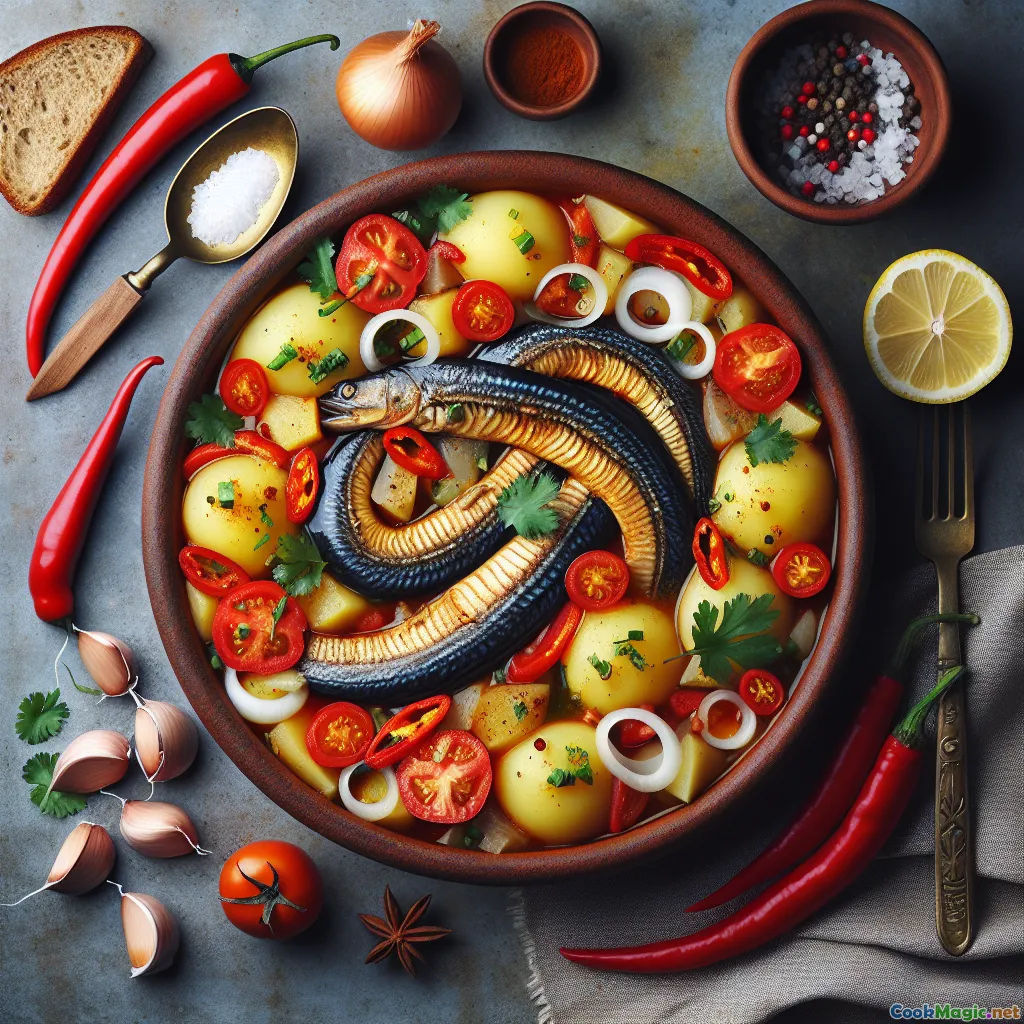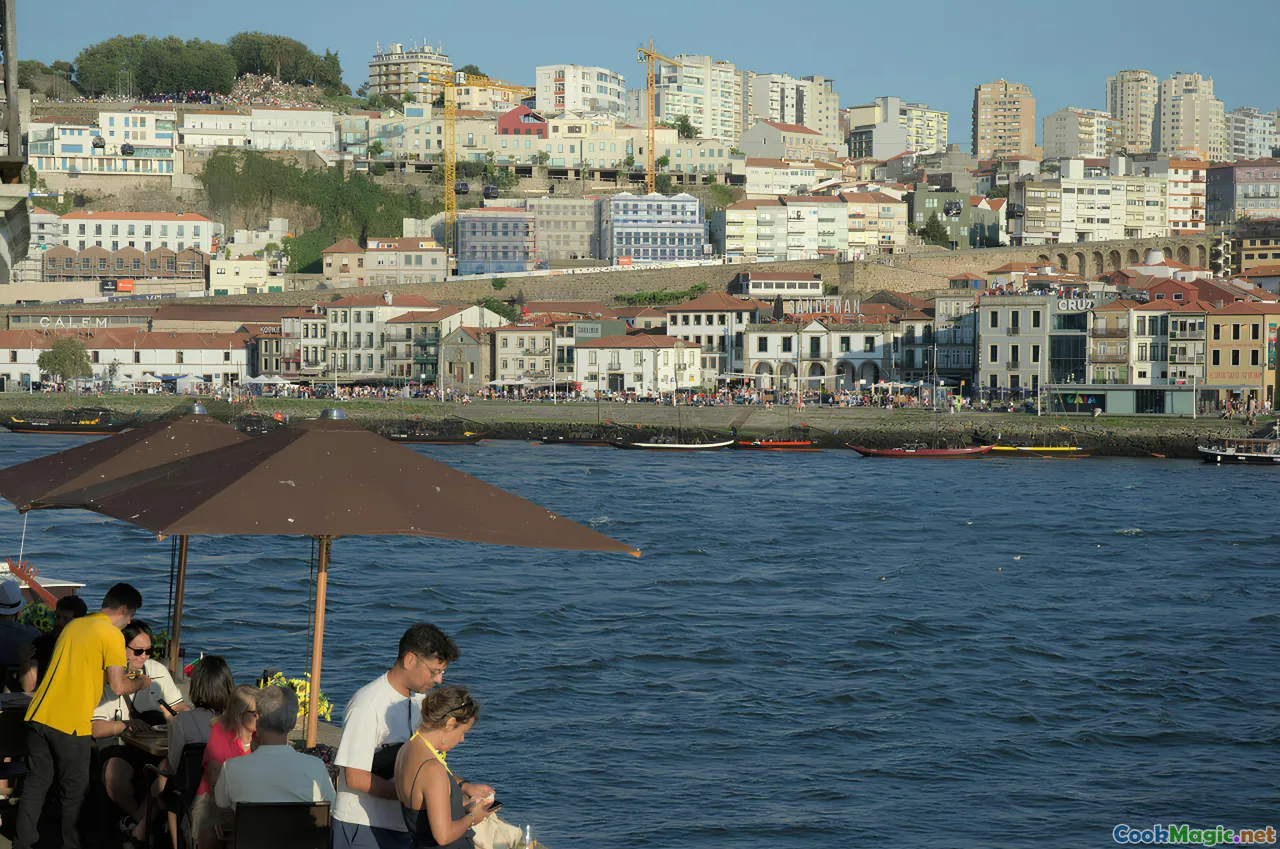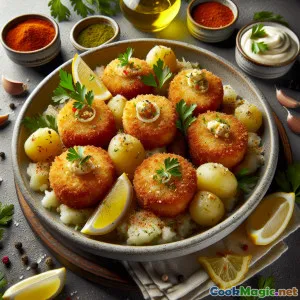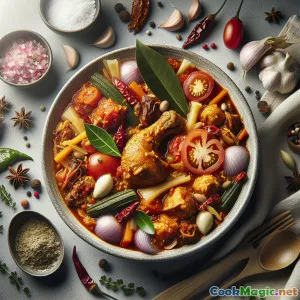
Кальдейрада из угрей реки Тежу, рагу рыбака по реке
(Tagus Eel Caldeirada, Fisherman’s River Stew)
(0 Обзоры)0
160
октябрь 12, 2025
Сообщить о проблеме
Ингредиенты
-
1200 grams Свежий угорь, очищенный и нарезанный на кусочки по 5 см
(Ask the fishmonger to gut and skin; keep backbone for flavor.)
-
800 grams Восковой картофель, нарезанный кружочками толщиной 1 см
(Choose a firm variety to hold shape.)
-
400 grams Лук, тонко нарезанный
(Forms the base sweetness of the stew.)
-
300 grams Спелые помидоры, нарезанные кубиками
(Use canned peeled tomatoes if out of season.)
-
150 grams красный болгарский перец, нарезанный ломтиками
(Adds color and gentle sweetness.)
-
6 cloves Чеснок (рубленый)
(Divide between marinade and pot.)
-
200 ml сухое белое вино
(Tejo region wine preferred.)
-
500 ml Рыбный бульон
(Homemade or low-sodium store-bought.)
-
60 ml Оливковое масло
(Portuguese extra virgin, for layering.)
-
8 grams Сладкая паприка (colorau)
(Classic Portuguese paprika.)
-
3 grams Копченая паприка
(Not traditional but adds depth.)
-
2 leaves Лавровые листья
(Свежий или сушеный)
-
15 grams Свежий кориандр (рубленый)
(Stems for simmering, leaves for finishing.)
-
10 grams Свежая нарезанная петрушка
(Дополнительная гарнир.)
-
1 piece Пири-пири чили, нарезанный ломтиками
(Adjust heat to taste.)
-
0.25 grams Нити шафрана
(Bloom in warm stock before adding.)
-
15 ml Лимонный сок или слабый уксус
(Helps temper eel richness.)
-
12 grams Морская соль
(Plus extra for lightly salting eel.)
-
3 grams Чёрный перец, свежемолотый
(Season to taste.)
-
6 slices Хлеб деревенский, нарезанный
(Day-old, for lining bowls.)
-
15 ml оливковое масло extra virgin для тостов
(Brush bread lightly before toasting.)
(Ask the fishmonger to gut and skin; keep backbone for flavor.)
(Choose a firm variety to hold shape.)
(Forms the base sweetness of the stew.)
(Use canned peeled tomatoes if out of season.)
(Adds color and gentle sweetness.)
(Divide between marinade and pot.)
(Tejo region wine preferred.)
(Homemade or low-sodium store-bought.)
(Portuguese extra virgin, for layering.)
(Classic Portuguese paprika.)
(Not traditional but adds depth.)
(Свежий или сушеный)
(Stems for simmering, leaves for finishing.)
(Дополнительная гарнир.)
(Adjust heat to taste.)
(Bloom in warm stock before adding.)
(Helps temper eel richness.)
(Plus extra for lightly salting eel.)
(Season to taste.)
(Day-old, for lining bowls.)
(Brush bread lightly before toasting.)
Питательная ценность
- Порции: 4
- Размер порции: 1 миска (350г)
- Calories: 780 kcal
- Carbohydrates: 0 g
- Protein: 42 g
- Fat: 35 g
- Fiber: 7 g
- Sugar: 8 g
- Sodium: 920 mg
- Cholesterol: 190 mg
- Calcium: 120 mg
- Iron: 3.2 mg
Инструкции
-
1 - Purge and prep eel:
Rinse eel pieces under cold water. If very slippery, rub lightly with coarse salt, splash with lemon juice, then rinse again. Pat dry. This tempers richness and improves texture.
-
2 - Season the eel:
In a bowl, toss eel with half the minced garlic, half the paprika, a pinch of salt, and black pepper. Add piri-piri if using. Rest while you prepare vegetables.
-
3 - Layer the base:
In a wide heavy pot or clay caçoila, drizzle olive oil. Layer half the onions, then half the potatoes. Scatter half the tomatoes and peppers. Tuck in bay leaves and cilantro stems.
-
4 - Add eel and seasonings:
Arrange eel pieces in a single layer. Top with remaining onions, potatoes, tomatoes, and peppers. Sprinkle remaining paprika, smoked paprika if using, and the rest of the garlic. Drizzle more olive oil.
-
5 - Deglaze and Simmer:
Pour in white wine and fish stock. Add saffron if using. Bring to a gentle boil, then cover and simmer on low until potatoes are tender and eel is silky, about 35–40 minutes. Do not stir; shake pot gently to avoid breaking layers.
-
6 - Toast the Bread:
Brush bread with a little olive oil and toast in a skillet or oven until crisp at the edges. Reserve for serving in bowls.
-
7 - Finish and Rest:
Taste broth and adjust salt, pepper, and acidity with a few drops of lemon juice. Stir in chopped cilantro leaves and parsley. Rest 3–5 minutes off heat.
-
8 - Serve river-style:
Line warm bowls with toasted bread. Ladle the caldeirada over, ensuring a little of each layer per serving. Eat carefully, watching for eel bones.
Rinse eel pieces under cold water. If very slippery, rub lightly with coarse salt, splash with lemon juice, then rinse again. Pat dry. This tempers richness and improves texture.
In a bowl, toss eel with half the minced garlic, half the paprika, a pinch of salt, and black pepper. Add piri-piri if using. Rest while you prepare vegetables.
In a wide heavy pot or clay caçoila, drizzle olive oil. Layer half the onions, then half the potatoes. Scatter half the tomatoes and peppers. Tuck in bay leaves and cilantro stems.
Arrange eel pieces in a single layer. Top with remaining onions, potatoes, tomatoes, and peppers. Sprinkle remaining paprika, smoked paprika if using, and the rest of the garlic. Drizzle more olive oil.
Pour in white wine and fish stock. Add saffron if using. Bring to a gentle boil, then cover and simmer on low until potatoes are tender and eel is silky, about 35–40 minutes. Do not stir; shake pot gently to avoid breaking layers.
Brush bread with a little olive oil and toast in a skillet or oven until crisp at the edges. Reserve for serving in bowls.
Taste broth and adjust salt, pepper, and acidity with a few drops of lemon juice. Stir in chopped cilantro leaves and parsley. Rest 3–5 minutes off heat.
Line warm bowls with toasted bread. Ladle the caldeirada over, ensuring a little of each layer per serving. Eat carefully, watching for eel bones.
Подробнее о: Кальдейрада из угрей реки Тежу, рагу рыбака по реке
Caldeirada de Enguias do Tejo
Caldeirada de Enguias do Tejo is the river soul of Portugal in a bowl. Born along the broad Tagus estuary and the Ribatejo plains, this fisherman’s stew harnesses a few honest ingredients—eel, potatoes, onions, tomatoes, paprika, and a generous splash of olive oil—to create something more than the sum of its parts. It is layered rather than stirred, cooked gently so that the juices from the eel mingle with the vegetables to form a saffron-tinted, paprika-scented broth with remarkable depth.
In the old river towns—Alcochete, Vila Franca de Xira, and Salvaterra de Magos—eel fishing once shaped daily life. Seasoned hands would set out at dawn and return with a writhing catch that demanded both skill and respect. The stew pot was the great equalizer: it welcomed what the river offered and made it tender, comforting, and sustaining for families and crews alike. The idea is simple and distinctly Portuguese: embrace layers. Onions soften into sweetness, potatoes give body, tomatoes lighten the broth with gentle acidity, peppers add perfume, and the eel provides gelatin and richness that unify the dish.
What makes this version special
- A proper river layering: no stirring, just careful stacking. This preserves texture and yields a clear, shimmering broth rather than a muddled soup.
- A kiss of Tejo white wine: it brightens the stew without overpowering the delicate eel character.
- Cilantro stems simmer in the pot while the leaves finish the dish, delivering two layers of herbal freshness.
- Toasted country bread in the bowl: the rustic, lightly crisped slices soak up the broth and turn each spoonful into comfort.
Tips and technique
- Managing eel’s slipperiness: a brief rub with coarse salt and a splash of lemon or mild vinegar helps remove the natural slime. Rinse and pat dry before seasoning.
- Cut consistency: aim for even 5 cm pieces so the eel cooks gently and uniformly without drying.
- Heat control: caldeirada likes a low, steady simmer. Overboiling can toughen eel and cause potatoes to break.
- No-stir rule: if the pot threatens to catch, gently shake it by the handles. This preserves the layered integrity.
- Rest before serving: five minutes off heat allows flavors to settle and bones to loosen slightly from the flesh.
Ingredient notes and substitutions
- Paprika: Portuguese colorau is sweet and round; if you use Spanish pimentón, begin with a touch less and adjust to taste.
- Saffron: not mandatory, but a small pinch lends golden warmth and a delicate floral lift.
- Heat: piri-piri is traditional for some river families; others keep it mild. Add to the marinade or serve on the side.
- Bread: day-old country bread is ideal because it soaks without disintegrating. Toasting adds texture and a hint of smoke.
Sustainability and sourcing
European eel is a culturally important fish but faces serious conservation challenges in many regions. When available, choose responsibly farmed eel from reputable sources. If local regulations limit availability, the technique and spirit of this caldeirada adapt well to sustainable alternatives with firm, gelatin-rich texture such as conger eel, catfish, or even monkfish tail. The stew’s layering, seasoning, and simmering will remain true to the dish’s character.
Serving and pairing
Serve the stew steaming over toasted bread, with a sprinkle of fresh cilantro and parsley. On the table, set a small dish of extra piri-piri for those who like more heat and a lemon wedge for brightness. A chilled Tejo white wine, Vinho Verde, or a light-bodied Douro red pairs beautifully, balancing the stew’s richness and amplifying its herbal notes.
Make-ahead and leftovers
Caldeirada is best enjoyed the day it is made, when the eel is silky and the potatoes are perfectly tender. If you have leftovers, reheat very gently over low heat with a splash of stock or water to loosen the broth. Avoid vigorous boiling to keep the eel delicate and the potatoes intact.
Cultural significance
This dish tells a story of river pragmatism and community. The caldeirada pot was a communal solution, built from what was abundant and shared around the table with bread to stretch the meal. Its flavors are unmistakably Portuguese: olive oil forward, paprika-scented, and herb-bright. Yet it is also a snapshot of place; as the river widens and the sea approaches, recipes shift, sometimes blending river eel with maritime fish to reflect the fluid border between freshwater and brine that defines the Tagus region.
Final thoughts
Cooked with care, Caldeirada de Enguias do Tejo is generous, aromatic, and deeply satisfying. The technique rewards patience more than precision, so trust your senses: the gentle bubbling, the perfume of bay and paprika, the broth just thick enough to cling to a spoon. Whether made with responsibly sourced eel or a thoughtful substitute, this stew offers an edible connection to Portugal’s great river and the people who have lived by its tides for generations.



















